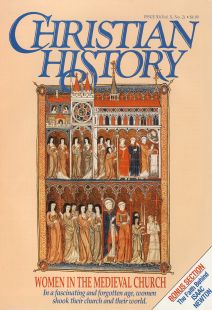Women in the Medieval Church: Recommended Resources
General Studies
In the past twenty years, especially, many books have been written on women in the Middle Ages. The editors have selected ten of these volumes that provide a helpful introduction or general study:
Susan G. Bell, ed., Women: From the Greeks to the French Revolution (Stanford, 1973).
Peter Dronke, Women Writers of the Middle Ages (Cambridge, 1984).
Margaret Wade Labarge, A Small Sound of the Trumpet: Women in Medieval Life (Beacon Press, 1986).
Frances and Joseph Gies, Women in the Middle Ages (Harper & Row, 1980).
Julius Kirshner and Suzanne F. Wemple, eds., Women of the Medieval World (Basil Blackwell, 1985).
Angela Lucas, Women in the Middle Ages: Religion, Marriage & Letters (St. Martin, 1984).
Eileen Power and M. M. Poston, Medieval Women (Cambridge, 1976).
Shulamith Shahar, The Fourth Estate: A History of Women in the Middle Ages (Routledge, Chapman & Hall, 1984).
Susan M. Stuard, ed., Women in Medieval Society (Pennsylvania, 1976).
Ruth A. Tucker & Walter Liefeld, Daughters of the Church: Women & Ministry from New Testament Times to the Present (Zondervan, 1987).
Multimedia
Hildegard of Bingen (Morehouse, 1990). Color VHS videotape, 60 min., $39.95, includes discussion guide. Four fifteen—minute segments introduce her life and writings.
Women of Spirit (University of Wisconsin; to order, 1–800–747–7444). Series of five audiotapes uses dramatic readings and scholarly explanations to introduce Catherine of Siena and others.
Further Study
It is impossible to study the medieval church without being struck by the prevalence of mystical experiences and writings. To guide readers who want to study this aspect more deeply, the editors asked Dr. Elizabeth A. Petroff, Professor of Comparative Literature at the University of Massachusetts, Amherst, to provide recommendations.
Rudolph Bell, Holy Anorexia (Chicago, 1985). Looks at medieval women’s asceticism in the light of modern research on anorexia.
Caroline Walker Bynum, Holy Feast and Holy Fast: The Religious Significance of Food to Medieval Women (California, 1987).
Lina Eckenstein, Women Under Monasticism (Cambridge, 1896). This remarkably readable history of medieval religious women was reprinted in the 1960s and is available in most libraries.
Richard Kieckhefer, Unquiet Souls: Fourteenth-Century Saints and Their Religious Milieu (Chicago, 1984). Introduces the lives of mystics, visionaries, and saints in this period, and shows how their spirituality was a response to the disturbances of their time.
Barbara Newman, Sister of Wisdom: St. Hildegarde’s Theology of the Feminine (California, 1987). A remarkable study that properly places Hildegarde as a major theologian; the translations are breathtaking.
Rosemary Reuther and Eleanor McLaughlin, Women of Spirit: Female Leadership in the Jewish and Christian Traditions (Simon and Schuster, 1979). Contains three important essays relevant to medieval mysticism.
Paul Szarmach, ed., An Introduction to the Medieval Mystics of Europe (SUNY, 1984). Contains several excellent essays on women mystics.
Evelyn Underhill, Mysticism: A Study in the Nature and Development of Man’s Spiritual Consciousness (Dutton, 1961. A reissue of the book originally published in 1911, justifiably a classic in the field.
Her smaller, more personal volume, The Mystics of the Church (London: James Clark, 1925), is concerned with “the great creative soul whose special experience of God does something for his fellow Christians. . . . ”
Donald Weinstein and Rudolph M. Bell, Saints and Society: The Two Worlds of Western Christendom, 1000–1700 (Chicago, 1982). A fascinating study that looks at patterns in saints’ childhood, adolescence, adulthood, family life, and religious practice.
Individual writers
The Classics of Western Spirituality Series by Paulist Press includes the following volumes:
St. Catherine of Siena: Dialogue (1987).
Hadewijch: Complete Works (1980).
Hildegard of Bingen: Scivias (1990).
Julian of Norwich: Showings (1978).
Translations/ Anthologies
Fiona Bowie, Beguine Spirituality. Mystical Writings of Mechthild of Magdeburg, Beatrijs of Nazareth, and Hadewijch of Brabant (Crossroad, 1989). A good introduction to beguine spirituality, and fine translations.
Elizabeth A. Petroff, Medieval Women’s Visionary Literature (Oxford, 1986). A thousand years of texts by women visionaries, many previously unrecognized or never translated.
Emilie Zum Brunn and Georgette Epiney-Burgard, Women Mystics in Medieval Europe (Paragon, 1989). Selections by Hildegard of Bingen, Mechthild of Magdeburg, and others.
By the Editors
[Christian History originally published this article in Christian History Issue #30 in 1991]
Next articles
The Faith Behind the Famous: Isaac Newton
He has been called “the greatest scientific genius the world has known.” Yet he spent less time on science than on theology.
Charles E. HummelChristian History Chronology: Significant Events in the Life of Isaac Newton
Chronology of Isaac Newton’ life and times.
Charles E. HummelReaders Respond to the 100 Events Issue
Which events should have been listed? Here’s what you said.
Kevin A. MillerSupport us
Christian History Institute (CHI) is a non-profit Pennsylvania corporation founded in 1982. Your donations support the continuation of this ministry
Donate



